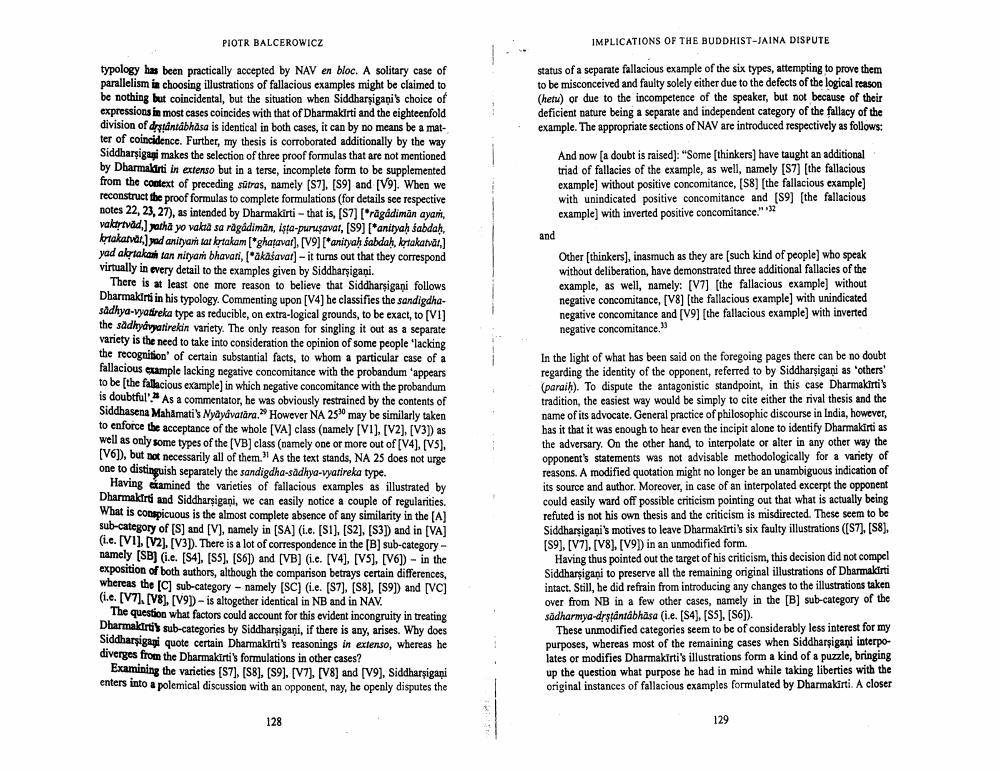________________
PIOTR BALCEROWICZ
IMPLICATIONS OF THE BUDDHIST-JAINA DISPUTE
status of a separate fallacious example of the six types, attempting to prove them to be misconceived and faulty solely either due to the defects of the logical reason (hetu) or due to the incompetence of the speaker, but not because of their deficient nature being a separate and independent category of the fallacy of the example. The appropriate sections of NAV are introduced respectively as follows:
And now (a doubt is raised): "Some (thinkers) have taught an additional triad of fallacies of the example, as well, namely (S7) (the fallacious example) without positive concomitance, (58) (the fallacious example) with unindicated positive concomitance and (89) (the fallacious
example) with inverted positive concomitance." and
Other (thinkers), inasmuch as they are (such kind of people who speak without deliberation, have demonstrated three additional fallacies of the example, as well, namely: (V7] [the fallacious example) without negative concomitance, (V8] (the fallacious example) with unindicated negative concomitance and [V9) [the fallacious example) with inverted negative concomitance."
typology has been practically accepted by NAV en bloc. A solitary case of parallelism in choosing illustrations of fallacious examples might be claimed to be nothing but coincidental, but the situation when Siddharsigaņi's choice of expressions in most cases coincides with that of Dharmakirti and the eighteenfold division of držántábhasa is identical in both cases, it can by no means be a matter of coincidence. Further, my thesis is corroborated additionally by the way Siddharsigani makes the selection of three proof formulas that are not mentioned by Dharmakirti in extenso but in a terse, incomplete form to be supplemented from the context of preceding sūtras, namely (S7). [S9) and (V9). When we reconstruct the proof formulas to complete formulations (for details see respective notes 22, 23, 27), as intended by Dharmakirti - that is, (S7) (ragddiman ayar, vaktstvad.) yatha yo vakta sa ragadimän, ista-punasavat, (59] [*anityah Sabdah, kytakarvat.) yad anityam tat krtakam [*ghatavar], [V9] [*anityah sabdah, kptakanvār] yad akatakan tan nityam bhavati, ["akašavat] - it turns out that they correspond virtually in every detail to the examples given by Siddharşigani.
There is at least one more reason to believe that Siddharsigani follows Dharmakirti in his typology. Commenting upon (V4) he classifies the sandigdhasadhya-vyanireka type as reducible, on extra-logical grounds, to be exact, to [VI] the sadhyávyatirekin variety. The only reason for singling it out as a separate variety is the need to take into consideration the opinion of some people 'lacking the recognition of certain substantial facts, to whom a particular case of a fallacious example lacking negative concomitance with the probandum 'appears to be the fallacious example in which negative concomitance with the probandum is doubtful'. As a commentator, he was obviously restrained by the contents of Siddhasena Mahamati's Myayavatāra. However NA 250 may be similarly taken to enforce the acceptance of the whole (VA) class (namely (VI), (V2), [V3]) as well as only some types of the (VB) class (namely one or more out of [V4), (5), [V6]), but not necessarily all of them." As the text stands, NA 25 does not urge one to distinguish separately the sandigdha-sadhya-vyatireka type.
Having examined the varieties of fallacious examples as illustrated by Dharmakirti and Siddharşigani, we can easily notice a couple of regularities. What is conspicuous is the almost complete absence of any similarity in the [A] sub-category of (S) and (V), namely in (SA) (i.c. [Sl], [S2], [S3]) and in [VA] (i.c. [VI]. (V2), [V3D). There is a lot of correspondence in the [B] sub-categorynamely (SB) (i.e. (S4). [S5]. [56]) and (VB) (i.c. (V4). [15], [V6]) - in the exposition of both authors, although the comparison betrays certain differences, whereas the [C] sub-category - namely (SC) (.e. (S7), (S8], [99]) and (VC] (i.c. (V7],[18], [19- is altogether identical in NB and in NAV.
The question what factors could account for this evident incongruity in treating Dharmakirtis sub-categories by Siddharşigani, if there is any, arises. Why does Siddharşigani quote certain Dharmakirti's reasonings in extenso, whereas he diverges from the Dharmakirti's formulations in other cases?
Examining the varieties (S7)[S8], [99]. (17), [V8] and [V9), Siddharsigani enters into a polemical discussion with an opponent, nay, he openly disputes the
In the light of what has been said on the foregoing pages there can be no doubt regarding the identity of the opponent, referred to by Siddharsigani as 'others' (paraih). To dispute the antagonistic standpoint, in this case Dharmakirti's tradition, the easiest way would be simply to cite either the rival thesis and the name of its advocate. General practice of philosophic discourse in India, however, has it that it was enough to hear even the incipit alone to identify Dharmakirti as the adversary. On the other hand, to interpolate or alter in any other way the opponent's statements was not advisable methodologically for a variety of reasons. A modified quotation might no longer be an unambiguous indication of its source and author. Moreover, in case of an interpolated excerpt the opponent could easily ward off possible criticism pointing out that what is actually being refuted is not his own thesis and the criticism is misdirected. These seem to be Siddharsigani's motives to leave Dharmakirti's six faulty illustrations ((S7), (S8), (59), [V7), [V8). [V9D) in an unmodified form.
Having thus pointed out the target of his criticism, this decision did not compel Siddharsigani to preserve all the remaining original illustrations of Dharmakirti intact. Still, he did refrain from introducing any changes to the illustrations taken over from NB in a few other cases, namely in the [B] sub-category of the sādharmya-drstantábhāsa (i.e. (S4), (SS), (S6]).
These unmodified categories seem to be of considerably less interest for my purposes, whereas most of the remaining cases when Siddharsigani interpolates or modifies Dharmakirti's illustrations form a kind of a puzzle, bringing up the question what purpose he had in mind while taking liberties with the original instances of fallacious examples formulated by Dharmakarti. A closer
128
129




